3. Why the Pilgrims? Mythology and Thanksgiving Day
1. a traditional or legendary story, usually concerning some being or hero or event, with or without a determinable basis of fact or a natural explanation,
...
5. an unproved or false collective belief that is used to justify a social institution.
Dictionary.com Unabridged (v 1.1)
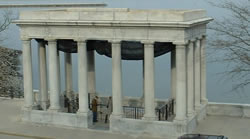
Illustration 1: The present (1920) superstructure designed by McKim, Mead, and White for the Tercentenary of Plymouth Rock.
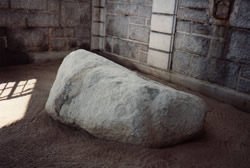
Illustration 2: Plymouth Rock
Almost a million people a year visit Plymouth Rock, and yet the Pilgrims did not land on it.
The first references to Plymouth Rock are found over 100 years after the actual landing.
When the Pilgrims came to America, they weren't leaving directly from England. They had already left eleven years prior, and were living in Leiden, Holland. The Pilgrims had a number of reasons to come to America, but a key reason was to protect their families. The Pilgrims wanted to move their families away from decadent Dutch influences, but also were motivated to provide relief for their children who “were, often times, so oppressed with their heavy labors, that though their minds were free and willing, yet their bodies bowed under the same, and became decrepit in their early youth; the vigor of nature being consumed in the very bud as it were.”3 Also a sagging economy and extreme personal financial crises and the threat of war with an invasion from Spain. The last reason4 was to spread the Gospel , but they did not leave Holland to go to America for religious freedom.5 In fact the Pilgrims were so well respected in Holland that were it not for the tension between the Dutch and English governments, they would have been given honors and even public stations.6 Our perspective on the origins of Thanksgiving needs to be reevaluated based on historical facts, not modern traditions and myths. (read the chapter linked in the foot note for a first hand account of their reasons titled “Showing ye reasons & causes of their remoovall”[sic])7
This is a view of the origins of Thanksgiving that existed in 1879. The article from which this was taken was written to address the very issue of the origins of Thanksgiving. It is suggested that even in 1879, that the origins of Thanksgiving were more based on stories than on historical facts.THERE is a certain tradition which wanders about New England in a lawless kind of way, and which undertakes to account for the origin of our old festival of Thanksgiving. The story runs somewhat as follows: In the early days of the New England settlements, the people somewhere were gathered together to consider the propriety of appointing a day for fasting and prayer, in view of the many sorrows and calamities by which they were then encompassed. One brother, more cheerful-hearted than the rest, ventured to suggest the propriety of counting up the many blessings which had fallen to their lot, and impressed his thought so deeply upon the minds of those present, that they concluded to appoint a day of thanksgiving instead of a day of fasting. From this ancient circumstance we have our modern autumnal festival.
Our New England Thanksgiving, Historically Considered, Rev. I. N. Tarbox, D.D 1879
In all history, there is an inner circle of facts which are often hard to find. They were so natural and common-place at the time, that no particular record was made of them, and they lie buried in the tomb of forgetfulness.
Our New England Thanksgiving, Historically Considered, Rev. I. N. Tarbox, D.D 1879
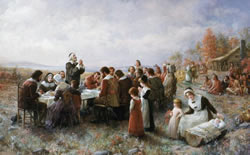
Illustration 3: "The First Thanksgiving at Plymouth" (1914) By Jennie A. Brownscombe
Jennie Brownscombe’s popular interpretation of the First Thanksgiving has become a symbol of the holiday for many Americans. It reached a wide audience and influenced the national understanding when it was printed in Life magazine.
Painted during the "Colonial Revival Period," Brownscombe chose some details that are inconsistent with history (such as the log cabin and the Sioux feather headdress) to symbolize early America. The entire image, however, with its elements of religious solemnity, feasting and community has a strong emotional appeal even today and shows a Thanksgiving with which early twentieth century Americans would feel comfortable.
http://www.pilgrimhall.org/hpbrowns.htm
Lets compare our understanding of Thanksgiving with that of a modern periodical. This may demonstrate how inadequate our current understanding really is. Here's the first paragraph of an article on Thanksgiving from the children's magazine Highlights, November 2006.
Most people think Thanksgiving dinner is incomplete without mashed potatoes, cranberry sauce, and pumpkin pie. It might surprise you to learn that not one of those foods was served during the 1621 celebration we think of as “The First Thanksgiving.” Actually the event itself was not even a Thanksgiving observation. Instead, to the English colonists we now call “Pilgrims,” it was a harvest celebration.
Highlights Children's Magazine, Nov 2005 (emphasis added)
This one paragraph addresses a number of issues that are confirmed and reiterated over and over again by many sources and historians. The mythical “first thanksgiving” wasn't a thanksgiving but a harvest festival, the food we eat on thanksgiving has little or nothing to do with the “first thanksgiving” and that the “Pilgrims” weren't even called “Pilgrims”. These are just a few of the myths surrounding Thanksgiving.
Making a Myth
There was neither cranberry sauce nor pumpkin pie at the 1621 harvest celebration. There were no Indians with woven blankets over their shoulders and large feathered headdresses cascading down their backs. There were no Pilgrims in somber black clothes and tall hats with silver buckles, either. The English didn't even call themselves Pilgrims at the time. That's the myth.
The 19th century painters who created these dramatic images were just plain wrong. ... These images have been reproduced in so many schoolrooms and pageants and illustrations that people think they must be true.
1621: A New Look at Thanksgiving, Catherine O'Neill Grace
This painting by Jennie Brownscombe is a typical romantic 19th century image of the English at Plymouth. Such paintings distorted what really happened in 1621.
1621: A New Look at Thanksgiving, Catherine O'Neill Grace
"The First Thanksgiving at Plymouth" (1914) By Jennie A. Brownscombe

Illustration 4: N.C. Wyeth, Mural from Plymouth Colony Series, 1940
The Pilgrims and their “first thanksgiving” is a key myth that is at the very core of the meaning of the American Thanksgiving Day celebration. The “first thanksgiving” in 1621, was not even the “first” in our country, let alone an actual “thanksgiving”. There are a number of other actual thanksgivings that occurred before this, in the years 1541, 1564, 1607 and 1610.8 This again is evidence that “thanksgiving” wasn't started by the Pilgrims, but came from somewhere else entirely.Decorative buckles are far-fetched and lack any basis in reality. They began showing up in paintings of Thanksgiving rendered in the late 19th century. The buckles fascinate Baker, [historian from Plymouth Plantation] who has a theory that when you want to create a mythological figure, you give the figure large buckles. “Who has big buckles?” he asks, answering, “Witches, leprechauns, Santa Claus and Pilgrims.”
The Book of Thanksgiving, Paul Dickson
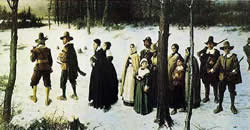
Illustration 5: Pilgrims Going to Church by George H. Boughton
The traditional Thanksgiving Day myth begins with the landing of the Pilgrims and the establishment of the Plymouth colony in Massachusetts in December 1620.
The Book of The Year A Brief History of our Seasonal Holidays, Anthony F. Aveni
Our images of Pilgrims come in large measure from paintings such as the classic and drab painting Pilgrims Going to Church by George H. Boughton, which depicts a dozen somberly men, women and children trudging through the snow shouldering muskets against possible Indian attack.
The Book of Thanksgiving, Paul Dickson
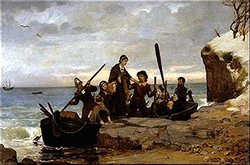
Illustration 6: The Landing of the Pilgrims., by Henry A. Bacon, 1877
The relationship of the Pilgrims to Thanksgiving Day is a relatively modern phenomenon. Here's a reference to the fact that historical documents that described the actions of the Pilgrims and their “first thanksgiving” were not even discovered until after thanksgiving celebrations had long been a part of the American culture.
Much of the confusion relating to the Pilgrims is due to the lack of a clear identification of these people. In reality the “Pilgrims” were really Separatists. The Separatists were those that decided that the only way to have a pure religion was to “separate” themselves from the Church of England. More than half of the people on the Mayflower were not Separatists, but were simply on board to make money. The Pilgrims called them “strangers”. (For the sake of consistency, the “Separatists Pilgrims” may simply be referred to as “Pilgrims”)Although the only known contemporary account of the 1621 Plymouth harvest celebration had been rediscovered in 1841, the national Thanksgiving Day initially was not officially linked to it.
Columbia Electronic Encyclopedia 9
In 1691 Plymouth Colony was annexed into Massachusetts Bay Colony. The Massachusetts Bay colony was for all intents and purposes, a theocracy run by Puritans. Puritans did not desire to separate themselves from the Church of England, but simply wanted to “purify” it, hence the name “puritans”. The Pilgrims played a small roll in the development of New England culture and Thanksgiving.
The Puritans of Massachusetts Bay Colony had frequent recorded thanksgivings starting as soon as the colony was formed in 1630. Then again in 1631, 1632, 1633, 1637,1638.Turning now to the Colony of the Massachusetts Bay, it is well to bear in mind, that in the early years, the people there did not intend to copy after the Plymouth people. They “were a law unto themselves,” and had very little fancy for doing any thing, simply because those poor Pilgrims had done it. After the settlements began in strength, in 1630, it was quite common with the Puritans of the Bay to appoint thanksgiving days for various reasons.
They had one in July, 1630, for the safe arrival of the many ships which left England with Governor Winthrop, in the Spring of that year. Winthrop’s journal says: “Thursday, July 8, 1630. We kept a day of Thanksgiving in all the plantations.” By “all the plantations,” is meant the little towns and settlements then just beginning— Salem, Dorchester, Watertown, Charlestown, etc. The next February, when the ship Ambrose arrived bringing provisions, greatly needed, the same journal reports: “We held a day of Thanksgiving for this ship’s arrival, by order from the Governour and Council directed to all the plantations.” Boston, separate from the other places, had a day of Thanksgiving October 11, 1631, because of the safe arrival of Mrs. Winthrop and the younger children; though the babe of the little flock, born after the father had left England, had died on the voyage and been buried in the sea. But their thoughts also went out, in reference to Thanksgiving days, upon broader ranges. On the 5th of June, 1632, a day of Thanksgiving was appointed...
Our New England Thanksgiving, Historically Considered, Rev. I. N. Tarbox, D.D 1879
This clearly indicates that one of the true origins of Thanksgiving is directly from England via the religious traditions of the Puritans. These Puritans were adamant that they were not separating from the Church of England as the Separatist Pilgrims had. Therefore it can be concluded that these many days of thanksgiving in Massachusetts Bay Colony were directly influenced by their religious base, the Church of England.In like manner the Massachusetts Colony had her autumnal Thanksgivings in 1665, 1666, 1667, 1669, 1670, 1672, 1673, 1676, 1677, 1680, 1681, 1682 and 1684. We need not carry the record farther. It is evident that every thing was ripening toward a fixed and regular yearly appointment...
Our New England Thanksgiving, Historically Considered, Rev. I. N. Tarbox, D.D 1879
These statements indicate that the Separatists were concerned about the religious purity of the Church of England and even called it “Rome”. So when and how were the Separatist Pilgrims linked to Thanksgiving Day?"We will not say, as the separatists were wont to say at their leaving of England, 'Farewell, Babylon!' 'farewell, Rome!' but we will say, 'farewell, dear England! farewell, the Church of God in England, and all the Christian friends there ! We do not go to New-England as separatists from the Church of England ...” And so he concluded with a fervent prayer for the King, and church, and state, in England ;
Rev. John Higginson (one of two ministers that lead the Churches in the Massachusetts Colony when it was founded)
Magnalia Christi Americana: Or, The Ecclesiastical History of New-England, by Cotton Mather 1855
Sarah Hale, Thanksgiving Day's most active proponent of the festival in the 19th century, rarely mentioned the Pilgrims in her campaign to create the national holiday, and only near the end of her campaign. In fact, Mrs. Hale accredited the origins of Thanksgiving in America to Boston and the Puritans, not the Pilgrims.There were isolated references to the Pilgrims’ First Thanksgiving after 1841, but none of any significance.
...
A survey of standard primary school textbooks from 1900 to 1940 shows that references to the Pilgrims often omitted any mention of the 1621 Thanksgiving. Nevertheless, there was sufficient awareness of the 1621 myth among the American public to prepare the nation for a widespread acceptance of the “First Thanksgiving” by World War Two.
Encylopedia of American Holidays and National Day, 2006
To the Colony of Massachusetts belongs the honor of introducing this holiday, soon after the settlement of Boston, though the exact date is not known. From that Colony the observance of Thanksgiving became the custom in all New England,
Godey's Lady's Book, Sarah Hale 1870
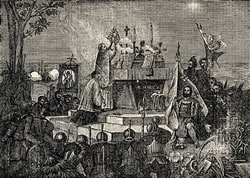
Illustration 7: An engraving depicts the first Catholic Mass held in St. Augustine on Sept. 8, 1565. Some historians consider this to be the first actual thanksgiving in America.
http://hnn.us/roundup/entries/18648.html
Historians have traced the connection of the Pilgrims to Thanksgiving Day to the middle of the 18th century when old documents were discovered in England that detailed the early lives of the Pilgrims. Here is a quote from an article printed in 1866 that details the origins of Thanksgiving. It demonstrates how new the idea of a Pilgrims' “first thanksgiving” really was.It wasn't until the latter half of the nineteenth century that our nations leaders trained their nostalgia on the “first” American Thanksgiving. The spirit of that shared, multicultural feast in 1621 provided an ideal symbol of America's new self-image as a melting pot.
The Thanksgiving Ceremony, Edward Bleier
The real Pilgrim “first thanksgiving” happened two years after the myth based “first thanksgiving” of 1621. The Pilgrims actually described the event in 1623 as a “day of thanksgiving”11, but not the event in 1621. There are only four recorded events of the Pilgrims that could be classified as “thanksgivings”; the event of July 1623 was the first, the next were October 29th 1668, June 7th, October 20th and November 26th 1690. After this Plymouth colony combined with Massachusetts Bay colony.The first Thanksgiving Day observed by the Plymouth Colonists, was on this wise: During the year 1622, they were greatly reduced in strength, and disheartened for want of sufficiency of suitable food. Great pains were taken, in seed-time and planting time, to procure an abundant harvest in 1623,
The Christian Recorder, January 1866
The Pilgrims and Puritans in general held days of thanksgiving as religious days of worship, which was also the case in 1623. The description of the event in 1621 is that of a harvest festival, not a religious event.12
In the same article from the Christian Recorder, written in 1866, another point of origin for Thanksgiving Day is cited. A thanksgiving on February 22nd 1631 in the Massachusetts Bay Colony in which a day of fasting was turned into a day of thanksgiving because of similar circumstances to the Pilgrim's 1623 thanksgiving. The colony was low on food when a ship came into port with food from Ireland bringing supplies. Another thanksgiving on October 16th 1633 was the first that was observed throughout all the colonies.
Thanksgiving was annually declared in Connecticut in 1643 and every year since until now, breaking this tradition only one year.Oct. 1, 1633. — Thanksgiving-day appointed by the General Court, — the first on record. It was as follows: " In regard to the many and extraordinary mercies which the Lord hath been pleased to vouchsafe of late to this plantation, — viz., a plentiful harvest, ships safely arrived with persons of special use and quality, &c., — it is ordered that Wednesday, 16th of this present month, shall be kept as a day of public thanksgiving through the several plantations."13
History of the Town of Medford, Middlesex County, Massachusetts, 1630-1855, January 1855
The colony in Connecticut is given quite a bit of credit for creating the real roots for an annual thanksgiving day. It's important to understand that days of thanksgiving were not annual events to the Puritans and Pilgrims, they were called any time of the year in response to divine intervention. Even President Lincoln proclaimed two thanksgivings in 1863, one is the famous “last Thursday of November” that started our modern traditional timing, (by an appeal from Sarah Hale) the other was on August 6th....the observance soon became the ordinary custom, appears from the law enacted by the New Haven Colonists in 1643
The Christian Recorder, January 1866
The article in the Christian Recorder in 1866 was titled “Origins of Thanksgiving”. It contradicts the idea that the Pilgrim's first “thanksgiving” in 1621 is the origin of Thanksgiving Day. Historians agree with this general assessment as well. The Pilgrims and their 1621 "First Thanksgiving" were only solidly cemmented with the history of Thanksgiving in the 20th century.
By the post-World War II period, Thanksgiving was the primary focus of the Pilgrim story in popular culture. The association of the popular holiday with its supposed Pilgrim origin had become a self-evident historical truth – the world had been sold on the “Pilgrim” brand of Thanksgiving.
Encylopedia of American Holidays and National Days, 2006
The historical evidence shows that the the acts and the beliefs of the Pilgrims have had very little, if anything, to do with the origins of Thanksgiving Day. So what is Thanksgiving Day without a “first thanksgiving”?
References
http://books.google.com/books?id=tYecOAN1cwwC&printsec=titlepage#PPA22,M1